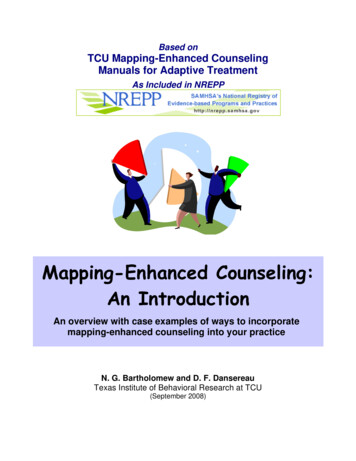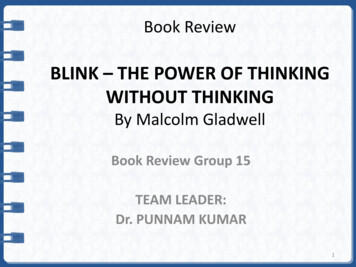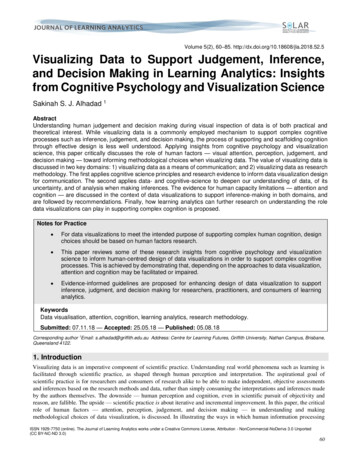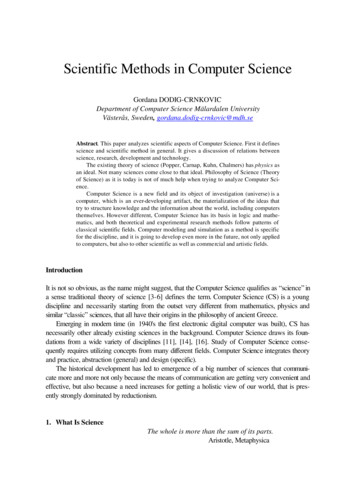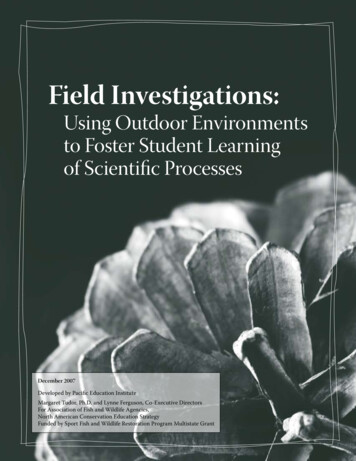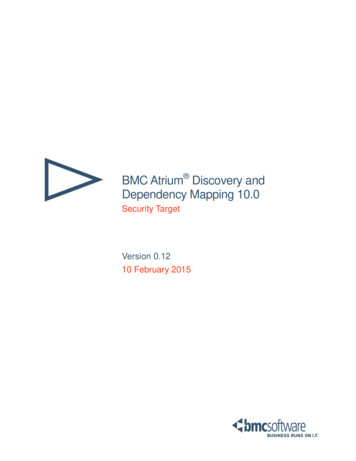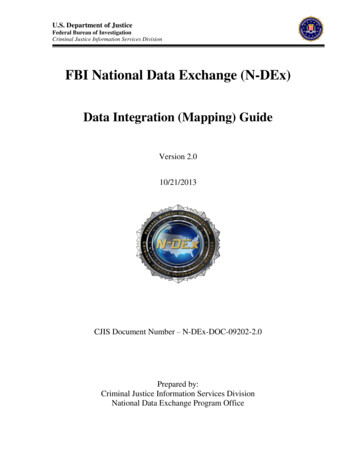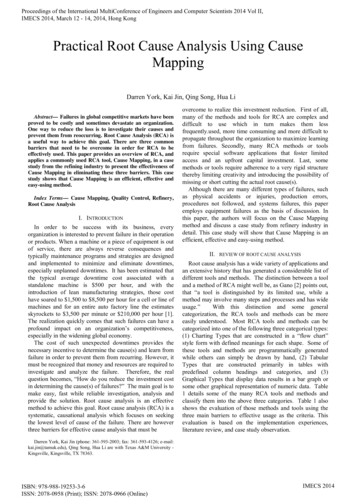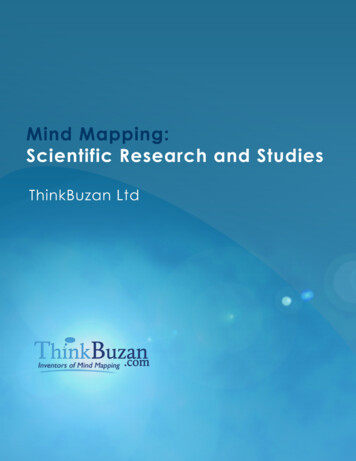
Transcription
Mind Mapping: Scientific Research andStudiesContentsPage 2 - 6PART 1RESEARCH STUDIES ON MIND MAPPINGPage 7 - 25Summary Report - Research Studies on Mind MappingPage 7 - 14Boost your memoryPage 8Foster your creativity with Mind MapsPage 8 - 9How Mind Maps facilitate the learning processPage 9Mind Maps as a teaching aidPage 9 - 10Prepare with a MindMapPage 10Improve your presentationsPage 10Mind Maps as a tool for collaborationPage 11Improve your writingPage 11Organise your thoughtsPage 11 - 12ReferencesPage 13 - 142
Extended Report - Research Studies on Mind MappingPage 15 - 25Mind Mapping boosts your memoryPage 16 - 17Mind Mapping fosters creativityPage 17Mind Mapping enhances learningPage 17 - 18Mind Mapping supports effective teachingPage 19 - 20Mind Mapping helps you plan and organisePage 20Mind Mapping enhances presentation skillsPage 21Mind Mapping promotes group collaborationPage 21Mind Mapping improves writing skillsPage 21 - 22Mind Mapping encourages critical thinking and problem-solvingPage 22ReferencesPage 23 - 25PART 2THE EVIDENCE SUPPORTING MIND MAPPINGPage 26 - 45Summary Report – The Evidence Supporting Mind MappingPage 27 - 30Radiant thinkingPage 27Mind Maps make a statement with colourPage 27The use of images in Mind MapsPage 27 - 28Using key wordsPage 28Whole brain thinkingPage 29Associations and connectionsPage 293
The memory technique of ‘chunking’Page 29ReferencesPage 30Extended Report – The Evidence Supporting Mind MappingPage 31 - 45Radiant, organic structure – works just like your brainPage 32 - 33Basic Ordering Ideas – setting the frameworkPage 33 - 34Single key words – free up your mindPage 35Lots of stimulating colourPage 36 - 37The power of images and iconsPage 37 - 39Relationship arrows – making connectionsPage 40Emphasising and ‘chunking’Page 40 - 41Whole brain thinkingPage 41 - 43ReferencesPage 44 - 45PART 3RESEARCH STUDIES ON MIND MAPPINGIN EDUCATIONPage 46 - 84Summary Report - Research Studies on Mind Mappingin EducationPage 47 - 52The efficacy of the Mind Map study techniquePage 47Mind Maps as a classroom exercisePage 47 - 48The use of Mind Mapping in teaching and learningPage 484
Enhancing students’ writing skills with Mind MapsPage 49Mind Mapping as a tool in mathematics educationPage 49Mind Mapping in executive educationPage 50Mind Maps can help improve memoryPage 50Mind Mapping and DyslexiaPage 51ReferencesPage 52Extended Report - Research Studies on Mind Mappingin EducationPage 53 - 84The efficacy of the ‘Mind Map’ study techniquePage 54 - 55Student and teacher perceptions of Mind MappingPage 55 - 56Mind Maps as a learning technique in chiropractic educationPage 56 - 57Mind Mapping for improving student academic performancePage 57 - 58Mind Mapping in executive educationPage 58 - 59Mind Maps as classroom exercisesPage 60Mind Mapping for creativity in engineering educationPage 62The use of Mind Mapping in teaching and learningPage 62 - 63Mind Maps for brainstorming on curriculum issuesPage 63 - 64Collaboration, ICT and Mind MappingPage 64 - 65The influence of Mind Mapping on science achievementPage 65 - 66Enhancing students’ writing skills with Mind Mapping softwarePage 66 - 67Mind Maps for critical thinking and holistic nursing carePage 67 - 68Mind Mapping as a tool in qualitative researchPage 68 - 695
Mind Mapping in learning and teaching: Pupil and teacher perspectivesPage 69 - 70Mind Mapping for enhancing students’ writingPage 71Using Mind Maps to raise standards in literacy and improve confidencePage 72 - 73Effectiveness of Mind Maps as a learning tool for medical studentsPage 73 - 74Using Mind Maps to teach social problem analysisPage 74 - 75Mind Mapping as a tool in mathematics educationPage 75 - 76Mind Maps for reading with understandingPage 76 - 77Mind Maps for enhancing reading comprehensionPage 77 - 78How Mind Maps improve memoryPage 78 - 79Mind Mapping and DyslexiaPage 79Mind Mapping: A graphic organiser for the pedagogical toolboxPage 80 - 81Mathematical Mind MappingPage 81Mind Mapping and concept mapping as tools in Mathematics education Page 81 - 82Online learning programmes using Mind MappingPage 83Mind Mapping helps children remember lessonsPage 83 - 846
PART 1RESEARCH STUDIES ON MIND MAPPINGSummary Report7
Summary Report - Research Studies on Mind MappingThe phenomena of Mind Mapping is now world-renowned, so why is it that millions of people aroundthe globe find it such a useful tool for creative thinking, planning and collaborating with others?There are numerous studies providing overwhelming evidence verifying the science behind MindMapping, so here are some of the exciting results that are confirmation as to exactly why Mind Mappingcan help you.Boost your memoryAt the heart of Mind Mapping is the striking combination of imagery, colour and visual-spatialarrangement, which is proven to significantly improve information recall, compared to conventionalmethods of note taking and learning.A study by Toi (2009) 1 shows that Mind Mapping can help children recall words more effectively thanusing lists, with improvements in memory of up to 32%.And according to a study conducted by Farrand, Hussain and Hennessey (2002) 2, Mind Mappingimproved the long-term memory of factual information in their participants by 10%.Foster your creativity with Mind MapsEver suffer from writer’s block? Do you experience brain freeze rather than brainstorm? This is whereMind Maps can help you. Their spatial layout helps you gain a better overview and makes newconnections more visible so you can create an infinite number of thoughts, ideas and associations onany topic – perfect for fostering creativity and generating new ideas whenever the mood takes you.A study by Al-Jarf (2009) 3 confirms that Mind Mapping software offers a powerful approach forimproving the ability of anyone to generate, visualise and organise ideas. The subjects taking part in the1Toi, H (2009), ‘Research on how Mind Map improves Memory’. Paper presented at the International Conferencendthon Thinking, Kuala Lumpur, 22 to 26 June 2009.2Farrand, P., Hussain, F. and Hennessy E. (2002), ‘The efficacy of the ‘mind map’ study technique’. MedicalEducation, Vol. 36 (5), pp 426-431.8
study reported that the Mind Mapping tool encouraged creative thinking and they became faster atgenerating and organising ideas for their writing.How Mind Maps facilitate the learning processEvidence shows that Mind Maps can facilitate the learning process in a variety of ways:Interesting and engaging: Goodnough and Woods (2002) 4 discovered that partakers in their studyperceived Mind Mapping as a fun, interesting and motivating approach to learning. Several of theseparticipants attributed the fun aspect to the opportunity to be creative when creating Mind Mapsthrough lots of choice in colour, symbols, key words and design.Organisation and understanding: Research by D’Antoni and Pinto Zipp (2005) 5 found that, from apool of 14 physical therapy students, 10 out of 14 agreed that the Mind Map technique enabled them tobetter organise and integrate the material presented in their course.Concentration: A study conducted at Newchurch Community Primary School in Warrington showed avariety of improvements in pupils’ learning after Mind Mapping was introduced. Evidence includesimproved concentration, staying on task for longer periods of time, improved questioning andanswering during class discussions and improved independence. Cain (2001/2002) 6.Mind Maps also promote active learning, foster motivation, improve confidence, and support a diverserange of learning styles and levels of ability – all in a fun way!Mind Maps as a teaching aidMind Mapping provides an effective approach for promoting better understanding in learning andtraining. Its flexibility also means that it possesses several uses when teaching.3Al-Jarf, R. (2009), ‘Enhancing Freshman students’ Writing Skills with a Mind Mapping software’. Paper presentedthat the 5 International Scientific Conference, eLearning and Software for Education, Bucharest, April 2009.4Goodnough, K. and Woods, R. (2002), ‘Student and Teacher Perceptions of Mind Mapping: A Middle School CasestStudy’. Paper presented at the Annual Meeting of American Educational Research Association, New Orleans, 1 toth5 April 2002.5D’Antoni, A. V., and Pinto Zipp, G. (2005), ‘Applications of the Mind Map Learning Technique in ChiropracticEducation’. Journal of Chiropractic Education, 19:53-4.6Cain, M. E. (2001/2002), ‘Using Mind Maps to raise standards in literacy, improve confidence and encouragepositive attitudes towards learning’. Study conducted at Newchurch Community Primary School, Warrington.9
Using Mind Mapping for lesson planning can help teachers or trainers identify a logical plan or teachingroute and increases recall of the subject matter. This can boost teaching confidence and facilitate thesmooth running of programmes. Boyson (2009) 7.Furthermore Mento et al (1999) 8 affirm that Mind Mapping is a powerful cognitive tool which can beused in a variety of ways because of its ability to evoke associative and non-linear thinking.And finally, researchers, Goodnough and Long (2002) 9 found Mind Mapping to be a useful strategy forintroducing new concepts, providing a whole-class focus for a large research project, assessing learningof individuals and offering greater choice in how people chose to complete assignments and projects.Prepare with a Mind MapA study by Holland et al (2003/2004) 10 established Mind Mapping to be a valuable technique for helpingsomeone plan and structure projects and assignments more effectively. The experimental subjects inthis study were able to improve the structure, coherence and, consequently, the quality of their writtenwork and were able to draw value from the technique for project managing practical work. Testimonythat a Mind Map is an invaluable tool for planning and organising your thinking for any project!Improve your presentationsMento et al (1999) 11 observed that a number of executives made clear and compelling presentationsusing only a transparency of their Mind Map, without fumbling about with notes. They were also able tohandle challenging questions with confidence. Their ability to handle the presented material in such aneffective way was attributed to better recall of the information because it had been captured and storedin an integrated, radiating manner rather than linearly. They could also internalise it better because itwas their unique representation of the information.7Boyson, G. (2009), ‘The Use of Mind Mapping in Teaching and Learning’. The Learning Institute, Assignment 3.Mento, A. J., Martinelli, P. and Jones R. M. (1999), ‘Mind Mapping in Executive Education: Applications andOutcomes’. The Journal of Management Development, Vol. 18, Issue 4.9Goodnough, K. and Long, R. (2002), ‘Mind Mapping: A Graphic Organizer for the Pedagogical Toolbox’. ScienceScope, Vol. 25, No. 8, pp 20-24.10Holland, B., Holland, L. and Davies, J. (2003/2004), ‘An investigation into the concept of Mind Mapping and theuse of Mind Mapping software to support and improve student academic performance’. Learning and TeachingProjects 2003/2004, pp 89-94.11Mento, A. J., Martinelli, P. and Jones R. M. (1999), ‘Mind Mapping in Executive Education: Applications andOutcomes’. The Journal of Management Development, Vol. 18, Issue 4.810
Mind Maps as a tool for collaborationA Mind Map is an excellent tool for collaborating with others to develop plans or implement keyprojects. It allows you to harness the input of all members of a group in a dynamic and creative way.When used for group brainstorming sessions, Mind Mapping was seen to enhance critical thinking andco-operation as well as providing a solid basis for collaborative problem-solving. Groups involved in thesessions reported that they enjoyed expressing their opinions in a participative and open climate(Paykoc et al, 2004) 12.Improve your writingMind Mapping is a powerful tool for assisting any form of writing. In a study by Wai Ling (2004) 13 10 outof the 12 involved attributed their improvement in writing to the use of Mind Maps.Findings from an investigation by Al-Jarf (2009) 14 revealed that the written work produced by usingMind Mapping included: More relevant detail and better organised and connected ideas Mind Mapping raised the performance of students at all levels of ability as they became moreefficient in generating and organising ideas for their writing Those studied also displayed a positive attitude towards using Mind Mapping as a pre-writingactivityOrganise your thoughtsA Mind Map can help you think with greater clarity to explore relationships between ideas and elementsof an argument and to generate solutions to problems. It puts a new perspective on things by allowingyou to see all the relevant issues and analyse choices in light of the big picture. It also becomes easier tointegrate new knowledge and organise information logically as you aren’t tied to a rigid structure.12Paykoç, F., Mengi, B., Kamay, P. O, Onkol, P., Ozgur, B., Pilli, O. and Yildirim, H. (2004), ‘What are the MajorCurriculum Issues?: The Use of MindMapping as a Brainstorming Exercise’. Paper presented at the First Int.Conference on Concept Mapping, Spain, 2004.13Wai Ling, C. (2004), ‘The Effectiveness of Using Mind Mapping Skills in Enhancing Secondary One and SecondaryFour Students’ Writing in a CMI School’. University of Hong Kong, Masters dissertation.14Al-Jarf, R. (2009), ‘Enhancing Freshman students’ Writing Skills with a Mind Mapping software’. Paper presentedthat the 5 International Scientific Conference, eLearning and Software for Education, Bucharest, April 2009.11
Verifying this is research conducted by Mueller et al (2002) 15 describing how the use of Mind Maps toplan patient care at Front Range Community College resulted in enhanced thinking skills including criticalthinking, whole-brain thinking and comprehensive thinking.15Mueller, A., Johnston, M. and Bligh, D. (2002), ‘Joining Mind Mapping and Care Planning to Enhance StudentCritical Thinking and Achieve Holistic Nursing Care’. Nursing Diagnosis, 13, 1, pg. 24.12
References1. Toi, H (2009), ‘Research on how Mind Map improves Memory’. Paper presented at theInternational Conference on Thinking, Kuala Lumpur, 22nd to 26th June 2009.2. Farrand, P., Hussain, F. and Hennessy E. (2002), ‘The efficacy of the ‘mind map’ study technique’.Medical Education, Vol. 36 (5), pp 426-431.3. Al-Jarf, R. (2009), ‘Enhancing Freshman students’ Writing Skills with a Mind Mapping software’.Paper presented at the 5th International Scientific Conference, eLearning and Software forEducation, Bucharest, April 2009.4. Goodnough, K. and Woods, R. (2002), ‘Student and Teacher Perceptions of Mind Mapping: AMiddle School Case Study’. Paper presented at the Annual Meeting of American EducationalResearch Association, New Orleans, 1st to 5th April 2002.5. D’Antoni, A. V., and Pinto Zipp, G. (2005), ‘Applications of the Mind Map Learning Technique inChiropractic Education’. Journal of Chiropractic Education, 19:53-4.6. Cain, M. E. (2001/2002), ‘Using Mind Maps to raise standards in literacy, improve confidence andencourage positive attitudes towards learning’. Study conducted at Newchurch Community PrimarySchool, Warrington.7. Boyson, G. (2009), ‘The Use of Mind Mapping in Teaching and Learning’. The Learning Institute,Assignment 3.8. Mento, A. J., Martinelli, P. and Jones R. M. (1999), ‘Mind Mapping in Executive Education:Applications and Outcomes’. The Journal of Management Development, Vol. 18, Issue 4.9. Goodnough, K. and Long, R. (2002), ‘Mind Mapping: A Graphic Organizer for the PedagogicalToolbox’. Science Scope, Vol. 25, No. 8, pp 20-24.10. Holland, B., Holland, L. and Davies, J. (2003/2004), ‘An investigation into the concept of MindMapping and the use of Mind Mapping software to support and improve student academicperformance’. Learning and Teaching Projects 2003/2004, pp 89-94.11. Mento, A. J., Martinelli, P. and Jones R. M. (1999), ‘Mind Mapping in Executive Education:Applications and Outcomes’. The Journal of Management Development, Vol. 18, Issue 4.13
12. Paykoç, F., Mengi, B., Kamay, P. O, Onkol, P., Ozgur, B., Pilli, O. and Yildirim, H. (2004), ‘What arethe Major Curriculum Issues?: The Use of MindMapping as a Brainstorming Exercise’. Paperpresented at the First Int. Conference on Concept Mapping, Spain, 2004.13. Wai Ling, C. (2004), ‘The Effectiveness of Using Mind Mapping Skills in Enhancing Secondary Oneand Secondary Four Students’ Writing in a CMI School’. University of Hong Kong, Mastersdissertation.14. Al-Jarf, R. (2009), ‘Enhancing Freshman students’ Writing Skills with a Mind Mapping software’.Paper presented at the 5th International Scientific Conference, eLearning and Software forEducation, Bucharest, April 2009.15. Mueller, A., Johnston, M. and Bligh, D. (2002), ‘Joining Mind Mapping and Care Planning to EnhanceStudent Critical Thinking and Achieve Holistic Nursing Care’. Nursing Diagnosis, 13, 1, pg. 24.14
PART 1RESEARCH STUDIES ON MIND MAPPINGExtended Report15
Extended Report - Research Studies on Mind MappingAs Mind Mapping evolves on a global scale, an ever growing body of research is providing overwhelmingevidence that Mind Mapping using Tony Buzan’s guidelines works. Here are just some of the excitingresults documented in formal and academic papers and drawn from informal studies:Mind Mapping boosts your memoryThe Mind Mapping process involves a unique combination of imagery, colour and visual-spatialarrangement which is proven to significantly improve recall when compared to conventional methods ofnote-taking and learning by rote. A study by Farrand, Hussain and Hennessey (2002) 16 found that Mind Mapping improved the longterm memory of factual information in medical students by 10%. They reported that “Mind Mapsprovide an effective study technique when applied to written material” and are likely to “encouragea deeper level of processing” for better memory formation. Wickramisinghe et al (2007) 17 discovered that the majority of medical students who had been newlyintroduced to Mind Mapping perceived it to be helpful for memorising information in an organisedway compared to their previous self-study techniques. Research by Toi (2009) 18 shows that Mind Mapping can help children recall words more effectivelythan using lists, with improvements in memory of up to 32%. Incorporating Mind Mapping into the teaching of comprehension skills enhances students’understanding and memory of comprehension passages (Wong-Ang Gek Moi and Ong Lee Lian,2007) 19 Mind Mapping is a helpful method for remembering the relationships and steps that are necessaryfor mathematical processes (Entrekin, 1992) 20.16Farrand, P., Hussain, F. and Hennessy E. (2002), ‘The efficacy of the ‘mind map’ study technique’ MedicalEducation, Vol. 36 (5), pp 426-431.17Wickramisinghe A., Widanapathirana, N., Kuruppu, O., Liyanage, I. and Karunathilake I. (2007), ‘Effectivness ofmind maps as a learning tool for medical students’. South East Asian Journal of Medical Education, Vol.1, No.1(inaugural issue).18Toi, H (2009), ‘Research on how Mind Map improves Memory’. Paper presented at the International Conferencendthon Thinking, Kuala Lumpur, 22 to 26 June 2009.19Wong-Ang Gek Moi and Ong Lee Lian (2007), ‘Introducing Mind Map in Comprehension’. Educational ResearchAssociation (Singapore) 2007. Study conducted at Compassvale Primary School.20Entrekin, V. S. (1992), ‘Mathematical Mind Mapping’. The Mathematics Teacher, 85, 6, pg. 444, Sept 1992.16
Survey data collected by Mento et al (1999) 21 indicates that the majority of students appreciated thepower and simplicity of Mind Mapping and its “significant advantage over linear note-taking forrecall and creative thinking”.Mind Mapping fosters creativityMind Maps really come into their own for encouraging creativity and enabling you to generate newideas in brainstorming sessions. The spatial layout helps you gain a better overview and makes newconnections more visible so you can create an infinite number of thoughts, ideas, links and associationson any topic. Mind Mapping was selected as an effective strategy for encouraging creativity development inengineering students and was applied with encouraging results. It allowed creativity development tobe introduced into the curriculum in a way that made best use of the time available (Zampetakis etal, 2007) 22. When Mind Mapping was used as a brainstorming exercise to identify the major curricular issues inTurkey, it was apparent from the outcome that both the quality and quantity of the issuesgenerated had improved. Students reported that the exercise enabled them to perceive all theconcerns together as they were related to each other and they enjoyed expressing their opinionswithin a participative climate. The use of Mind Mapping software also allowed students the freedomto reflect, make changes and develop relationships in line with their thinking process (Paykoc et al,2004) 23. A study by Al-Jarf (2009) 24 proves that Mind Mapping software offers a powerful approach forimproving the ability of students to generate, visualise and organise ideas. The students involvedreported that the Mind Mapping tool encouraged creative thinking and they became faster atgenerating and organising ideas for their writing.Mind Mapping enhances learningEvidence shows that Mind Mapping offers a powerful system for learning. It harnesses visual appealthrough colour, symbols and images, and encourages students to make sense out of ideas byconstructing them in meaningful ways. This makes it ideal for promoting active learning, fostering21Mento, A. J., Martinelli, P. and Jones R. M. (1999), ‘Mind Mapping in Executive Education: Applications andOutcomes’ The Journal of Management Development, Vol. 18, Issue 4.22Zampetakis, L. A., Tsironis, L. and Moustakis, V. (2007), ‘Creativity Development in Engineering Education: TheCase of Mind Mapping’. Journal of Management Development, Vol. 26, No. 4, pp 370-380.23Paykoç, F., Mengi, B., Kamay, P. O, Onkol, P., Ozgur, B., Pilli, O. and Yildirim, H. (2004), ‘What are the MajorCurriculum Issues?: The Use of MindMapping as a Brainstorming Exercise’. Paper presented at the First Int.Conference on Concept Mapping, Spain, 2004.24Al-Jarf, R. (2009), ‘Enhancing Freshman students’ Writing Skills with a Mind Mapping software’ Paper presentedthat the 5 International Scientific Conference, eLearning and Software for Education, Bucharest, April 2009.17
motivation, improving confidence, and for supporting a diverse range of learning styles and levels ofability. Students also find it to be great fun! A study by Abi-El-Mona and Adb-El-Khalick (2008) 25 revealed that science students who used MindMapping achieved substantially higher gains in conceptual understanding and practical reasoningthan students using conventional study techniques. The personal, student-created structure andnature of Mind Mapping allowed students of different achievement levels to apply it in ways thatbest corresponded with how they recall information and assimilate their understanding of content. Mind Mapping has been shown to bring a renewed sense of enthusiasm to the classroom because itincreases student confidence and sense of skill in mastering assigned materials (Mento et al,1999) 26. Goodnough and Woods (2002) 27 discovered that students perceived Mind Mapping as a fun,interesting and motivating approach to learning. Several students attributed the fun aspect to theopportunity to be creative when creating Mind Maps through lots of choice in colour, symbols, keywords and design. Survey evidence collected by Budd (2004) 28 proves that Mind Mapping engages students in activelearning. In particular, students with higher scores for a ‘doing’ learning style benefited from MindMapping activities. D’Antoni and Pinto Zipp (2005) 29 found that, from a pool of 14 physical therapy students, 10 out of14 agreed that the Mind Map technique enabled them to better organise and integrate the materialpresented in their course. In a study conducted by Polsen (2003/2004) 30, the majority of students emphasised the flexibilitythat Mind Mapping offered in their learning. In particular, they appreciated the creative aspects ofthe technique and the assistance it gave them in understanding concepts and ideas. Improvedconfidence and more positive attitudes towards learning were also apparent. Mind Mapping caters to both verbal-linguistic and visual-spatial intelligences through itscombination of graphics, symbols and text. As such, it fosters expressive thinking and offers analternative means for students to share their knowledge and understanding (Goodnough and Long,25Abi-El-Mona, I. and Adb-El-Khalick, F. (2008), ‘The influence of Mind Mapping on eighth graders’ scienceachievement’. School Science and Mathematics.26Mento, A. J., Martinelli, P. and Jones R. M. (1999), ‘Mind Mapping in Executive Education: Applications andOutcomes’. The Journal of Management Development, Vol. 18, Issue 4.27Goodnough, K. and Woods, R. (2002), ‘Student and Teacher Perceptions of Mind Mapping: A Middle School CasestStudy’. Paper presented at the Annual Meeting of American Educational Research Association, New Orleans, 1 toth5 April 2002.28Budd, J. W. (2004), ‘Mind Maps as Classroom Exercises’. Journal of Economic Education, Vol. 35, No. 1, pp 35-49.29D’Antoni, A. V., and Pinto Zipp, G. (2005), ‘Applications of the Mind Map Learning Technique in ChiropracticEducation. Journal of Chiropractic Education, 19:53-4.30Polsen, K. (2003/2004), ‘How Do Pupils and Teachers View the Use of Mind Mapping in Learning & Teaching?’G.T.C Scotland Teacher Researcher Programme.18
2002) 31. This is a factor that also makes it beneficial for students who have difficulty with moretraditional ways of researching and writing (Peterson and Snyder, 1998) 32. A study conducted at Newchurch Community Primary School in Warrington showed a variety ofimprovements in pupils learning after Mind Mapping was introduced. This evidence includesimproved concentration, staying on task for longer periods of time, improved questioning andanswering during class discussions and improved independence (Cain, 2001/2002) 33.Mind Mapping supports effective teachingAs a pedagogical tool, the visibility of Mind Mapping provides an effective approach for promotingbetter understanding in students. Its flexibility also means that it possesses several uses in theclassroom. Using Mind Mapping for lesson planning can help teachers identify a logical teaching route andincreases recall of the subject matter. This can boost teaching confidence and facilitate the smoothrunning of lessons (Boyson, 2009) 34. A study by Polsen (2003/2004) 35 proved that using Mind Mapping as a pedagogical strategy led toimprovements in pupils learning. This was primarily built on helping them to develop soundcategorisation skills and then supporting them in depicting this information within a visual format.The study also revealed that the applications and advantages of Mind Mapping have cross curricularqualities, and can be potentially applied across all age ranges and learning abilities. D’Antoni and Pinto Zipp (2005) 36 recommend that educators incorporate Mind Mapping into theircurricula since it is easy to use and involves no cost. There are several options for utilising thetechnique - 1) pre-lecture format – integrating concepts from assigned readings prior to review byinstructor; 2) post-lecture format – integrating concepts from assigned readings and materialpreviously reviewed by instructor; and 3) case presentations. Mento et al (1999) 37 declare that Mind Mapping is a powerful cognitive tool which can be used in avariety of ways because of its ability to evoke associative and non-linear thinking. It was found to be31Goodnough, K. and Long, R. (2002), ‘Mind Mapping: A Graphic Organizer for the Pedagogical Toolbox’. ScienceScope, Vol. 25, No. 8, pp 20-24.32Peterson, A. R. And Snyder, P. J. (1998), 'Using Mind Maps to Teach Social Problems Analysis’. Paper presentedat the Annual Meeting of the Society for the Study of Social Problems, San Francisco, CA, Aug 1998.33Cain, M. E. (2001/2002), ‘Using Mind Maps to raise standards in literacy, improve confidence and encouragepositive attitudes towards learning’. Study conducted at Newchurch Community Primary School, Warrington.34Boyson, G. (2009), ‘The Use of Mind Mapping in Teaching and Learning’. The Learning Institute, Assignment 3.35Polsen, K. (2003/2004), ‘How Do Pupils and Teachers View the Use of Mind Mapping in Learning & Teaching?’.G.T.C Scotland Teacher Researcher Programme.36D’Antoni, A. V., and Pinto Zipp, G. (2005), ‘Applications of the Mind Map Learning Technique in ChiropracticEducation’. Journal of Chiropractic Education, 19:53-4.37Mento, A. J., Martinelli, P. and Jones R. M. (1999), ‘Mind Mapping in Executive Education: Applications andOutcomes’. The Journal of Management Development, Vol. 18, Issue 4.19
especially successful for case teaching, especially in EMBA programmes where students are requiredto gather, interpret and communicate large quantities of complex information. Mind Mapping offers a unique teaching approach when compared to many course exercises and assuch it can be used to revitalise a course mid way through its duration (Budd, 2004) 38. Researchers Goodnough and Long (2002) 39 found Mind Mapping to be a useful strategy forintroducing new concepts, providing a whole-class focus for a large research project, assessingstudent learning and offering greater choice in how students complete assignments and projects. Using Mind Mapping software in the classroom is a successful way to support children’s explorationand presentation of ideas. Ralston and Cook (2007) 40 found that an exercise involving Mind Mappingsoftware provided a useful focus
Boost your memory Page 8 . Foster your creativity with Mind Maps Page 8 - 9 . How Mind Maps facilitate the learning process Page 9 . Mind Maps as a teaching aid Page 9 - 10 . Prepare with a MindMap Page 10. Improve your presentations Page 10. Mind Maps as a tool for collaborati

